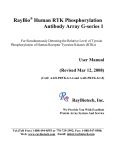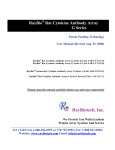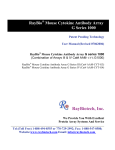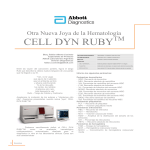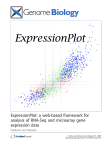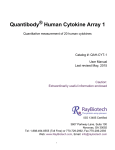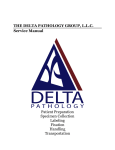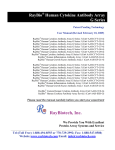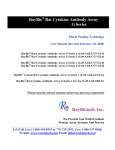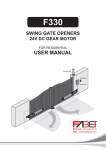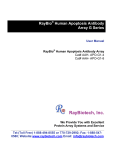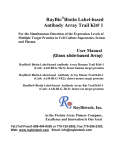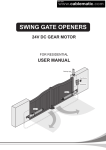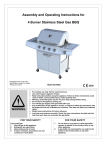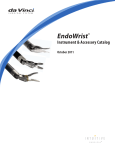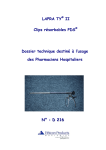Download RayBio Rat Cytokine Antibody Array
Transcript
RayBio® Rat Cytokine Antibody Array Patent Pending Technology User Manual (Revised 06/14/09) RayBio® Rat Cytokine Antibody Array 1 (Cat# AAR-CYT-1) RayBio® Rat Cytokine Antibody Array 2 (Cat# AAR-CYT-2) RayBio® Custom Ray Cytokine Antibody Array (Cat# AAR-CUST) RayBio® Rat Cytokine Antibody Array Service (Cat# AAR-SERV) Please read manual carefully before starting experiment RayBiotech, Inc. We Provide You with Excellent Protein Array Systems and Service Tel:(Toll Free) 1-888-494-8555 or 770-729-2992; Fax: 1-888-547-0580; Website: www.raybiotech.com Email: [email protected] HU UH HU U RayBiotech, Inc. RayBio® Rat Cytokine Antibody Array Protocol TABLE OF CONTENTS U I. Introduction……..………………………………2 How It Works…………………………………. .4 II. Materials Provided…………………………… 5 Additional Materials Required………………… 5 III. Overview and General Considerations……… 6 A. Preparation of Samples…………………… 6 B. Handling Array Membrane……………… .6 C. Incubation………………………………….6 IV. Protocol……………………………………… 7 A. Blocking and Incubation…………………. 7 B. Detection………………………………… 9 V. Interpretation of Results…………………… 10 VI. Troubleshooting Guide……………………… 13 VII. Reference List ……………………………… 14 Cytokine protein arrays are RayBiotech patent-pending technology. RayBio® is the trademark of RayBiotech, Inc. RayBio® Rat Cytokine Antibody Array Protocol 1 I. Introduction 0B All cell functions, including cell proliferation, cell death and differentiation, as well as maintenance of health status and development of disease, are controlled by a multitude of genes and signaling pathways. New techniques such as cDNA microarrays have enabled us to analyze global gene expression 1-3. However, almost all cell functions are executed by proteins, which cannot be studied simply through DNA and RNA techniques. Experimental analysis clearly shows a disparity between the relative expression levels of mRNA and their corresponding proteins 4. Therefore, analysis of the protein profile is critical. Currently, two-dimensional polyacrylamide SDS page coupled with mass spectrometry is the mainstream approach to analyzing multiple protein expression levels 5,6. However, the requirement of sophisticated devices and the lack of quantitative measurements greatly limit their broad application. Thus, effective study of multiple protein expression levels has been complicated, costly are timeconsuming until now. Our RayBio® Rat Cytokine Antibody Array is the first commercially available cytokine protein array system 7-11. By using the RayBiotech system, scientists can rapidly and accurately identify the expression profiles of multiple cytokines in several hours inexpensively. The RayBiotech kit provides a simple format and highly sensitive approach to simultaneously detect multiple cytokine expression levels from conditioned media, patient’s sera, cell lysate, tissue lysates and other sources. The RayBio® Mouse Cytokine Antibody Array C series 1000 can detect 96 mouse cytokines in single experiment. RayBiotech also provides RayBio® Human Cytokine Antibody Array C series 4000 which is the only product available in the market that can detect 274 human cytokines in single experiment. Traditionally, cytokines are detected by using ELISA (enzyme-linked immunsorbent assays); however, RayBiotech’s approach has several RayBio® Rat Cytokine Antibody Array Protocol 2 advantages over ELISA. First, and most important, our approach can simultaneously detect many cytokines. Secondly, the sensitivity is higher. With this approach, most cytokines can be detected at pg/ml levels. As little as 10 pg/ml of human IL-2 can be detected in the protein array format. Furthermore, the detection range is much greater than ELISA. For example, the detection range of human IL-2 varies from 10 to 100,000 pg/ml, whereas the detection range varies only within 100-1000 fold in a typical ELISA. Therefore, the detection range with protein arrays is greater than ELISA. Additionally, variability is far lower in comparison ELISA. As determined by densitometry, the variation between two spots ranged from 0 to 10% in duplicated experiments. In contrast, variation (about 20%) in ELISA is much higher. Finally, the system is much quicker and much easier to adapt to highthroughput techniques. Pathway-specific array systems allow investigators to focus on the specific problem and are becoming an increasingly powerful tool in cDNA microarray systems. RayBiotech’s first protein array system, known as RayBio® Rat Cytokine Antibody Array, is particularly useful in comparison with the mouse cytokine cDNA microarray system. Besides the ability to detect protein expression, RayBiotech’s system is a more accurate reflection of active cytokine levels because it only detects secreted cytokines, and no amplification step is needed. Cytokines play an important role in innate immunity, apoptosis, angiogenesis, cell growth and differentiation 12. They are involved in most disease processes, including cancer and cardiac diseases. The interaction between cytokines and the cellular immune system is a dynamic process. The interactions of positive and negative stimuli, and positive as well as negative regulatory loops are complex and often involve multiple cytokines. Without doubt, simultaneous detection of multiple cytokines provides a powerful tool to study cytokines. RayBio® Rat Cytokine Antibody Array Protocol 3 Here’s how it works Samples Array support Incubation of Sample with arrayed antibody supports 1-2 hrs Cocktail of Biotin-Ab Incubation with Biotinylated Ab 1-2 hrs Labeledstreptavidin Incubation with labeled-Streptavidin Detection of signals Data analysis and graph RayBio® Rat Cytokine Antibody Array Protocol 4 1 hrs II. Materials Provided Upon receipt, all components of the RayBio® Rat Cytokine Antibody Array kit should be stored at -200C to -800C. At -200C to -800C the kit will retain complete activity for up to 6 months. Once thawed, the array membranes and 1X Blocking Buffer should be kept at –200C and all other components should be stored at 40C. After thawing the reagents, the kit must be used within three months, and please use the kit within six months of purchase. • RayBio® Rat Cytokine Antibody Array membranes (2/4/8 membranes) • Biotin-Conjugated Anti-Cytokines (1/2/4 vials) (each vial is for two array membranes) • 1,000X HRP-Conjugated Streptavidin (50 μl) • 1X Blocking Buffer (15/25ml) • 20X Wash Buffer I (10/20ml) • 20X Wash Buffer II (10/20ml) • 2X Cell Lysis Buffer (10/20ml) • Detection Buffer C (1.5/2.5ml) • Detection Buffer D (1.5/2.5ml) • Eight-Well Tray (1 each) • Manual Additional Materials Required 1B • Small plastic boxes or containers • Orbital shaker • Plastic sheet protector or SaranWrap • Kodak x-omat AR film (REF 165 1454) and film processor or Chemiluminescence imaging system RayBio® Rat Cytokine Antibody Array Protocol 5 III. Overview and General Considerations 2B A. Preparation of Samples • Use serum-free conditioned media if possible. • If serum-containing conditioned media is required, use the serum as a control since many types of sera contain cytokines. • For cell lysates and tissue lysates, we recommend using 1X Cell Lysis Buffer to extract proteins from cell or tissue (e.g. using homogenizer). After extraction, spin the sample down and save the supernatant for your experiment. Determine the protein concentration. Dilute 2X Cell Lysis Buffer with H2O (we recommend adding proteinase inhibitors to Cell Lysis Buffer before use). • We recommend using 1 ml of Conditioned media or 1 ml of original or 10-fold diluted sera or 50-500 μg of protein for cell lysates and tissue lysates. 4BU If you experience high background, you may further dilute your sample. B. Handling Array Membranes • Always use forceps to handle membranes, and grip the membranes by the edges only. • Never allow the array membranes to dry during experiments. 5BU C. Incubation • Completely cover the membranes with sample or buffer during incubation, and cover the eight-well tray with a lid to avoid drying. • Avoid foaming during incubation steps. • Perform all incubation and wash steps under gentle rotation. • Several incubation steps such as step 2 (blocking), step 3 (sample incubation), step 7 (biotin-Ab incubation) or step 10 (HRP-streptavidin incubation) may be done at 40C for overnight. 6BU RayBio® Rat Cytokine Antibody Array Protocol 6 IV. Protocol 3B A. Blocking and Incubation U 1. Place each membrane into the provided eight-well tray (- means the antibody printed side). 2. Add 2 ml 1X Blocking Buffer and incubate at room temperature for 30 min to block membranes. Note: incubation may be done at 40C for overnight. 3. Incubate membranes with 1ml of sample at room temperature for 1 to 2 hours. Dilute sample using 1X Blocking Buffer if necessary. Note: We recommend using 1 ml of Conditioned media or 1 ml of original or 10-fold diluted sera or plasma or 50-500 μg of protein for cell lysates and tissue lysates. Dilute the lysate at least 10 folds with 1 X blocking buffer. Note: The amount of sample used depends on the abundance of cytokines. More of the sample can be used if the signals are too weak. If the signals are too strong, the sample can be diluted further. Note: Incubation may be done at 40C for overnight. 4. Decant the samples from each container, and wash 3 times with 2 ml of 1X Wash Buffer I at room temperature with shaking. Please allow 5 min per wash. Dilute 20X Wash Buffer I with H2O. 5. Wash 2 times with 2 ml of 1X Wash Buffer II at room temperature with shaking. Allow 5 min per wash. Dilute 20X Wash Buffer II with H2O. 6. Prepare working solution for primary antibody. RayBio® Rat Cytokine Antibody Array Protocol 7 Add 100 μl of 1X blocking buffer to the Biotin-Conjugated AntiCytokines tube. Mix gently and transfer all mixture to a tube containing 2 ml of 1X blocking buffer. Note: the diluted biotin-conjugated antibodies can be stored at 40C for 2-3 days. 7. Add 1 ml of diluted biotin-conjugated antibodies to each membrane. Incubate at room temperature for 1-2 hours. Note: incubation may be done at 40C for overnight. 8. Wash as directed in steps 4 and 5. 9. Add 2 ml of 1,000 fold diluted HRP-conjugated streptavidin (e.g. add 2 µl of HRP-conjugated streptavidin to 1998 µl 1X Blocking Buffer) to each membrane. Note: Mix the tube containing 1,000X HRP-Conjugated Streptavidin well before use since precipitation may form during storage. 10. Incubate at room temperature for 2 hours. Note: incubation may be done at 40C for overnight. 11. Wash as directed in steps 4 and 5. RayBio® Rat Cytokine Antibody Array Protocol 8 B. Detection U U * Do not let the membrane dry out during detection. The detection process must be completed within 40 minutes without stopping. 1. Proceed with the detection reaction. Add 250 μl of 1X Detection Buffer C and 250 μl of 1X Detection Buffer D for one membrane; mix both solutions. Drain off excess wash buffer by holding the membrane vertically with forceps. Place membrane protein side up (“-“ mark is on the protein side top left corner) on a clean plastic sheet (provided in the kit). Pipette the mixed Detection Buffer onto the membrane and incubate at room temperature for 2 minutes. Ensure that the detection mixture is completely and evenly covering the membrane without any air bubbles. 2. Drain off any excess detection reagent by holding the membrane vertically with forceps and touching the edge against a tissue. Gently place the membrane, protein side up, on a piece of plastic sheet (“-“ mark is on the protein side top left corner). Cover with another piece of plastic sheet on the array. Gently smooth out any air bubbles. Avoid using pressure on the membrane. 3. Expose the array to x-ray film (we recommend to use Kodak x-omat AR film) and detect signal using film developer. Or the signal can be detected directly from the membrane using a chemiluminescence imaging system. Expose the membranes for 40 seconds and then re-expose the film according to the intensity of signals. If the signals are too strong (background too high), reduce exposure time (e.g. 5-30 seconds). If the signals are too weak, increase exposure time (e.g. 5-20 min or overnight). Or re-incubate membranes overnight with 1x HRP-conjugated streptavidin, and redo detection in the second day. 4. Save membranes in –20 0C to –80 0C for future reference. RayBio® Rat Cytokine Antibody Array Protocol 9 V. Interpretation of Results: The following figure shows RayBio® Rat Cytokine Antibody Array membranes probed with conditioned media from two different cell lines. Membranes were exposed to Kodak x-omat film at room temperature for 1 minute. The biotin-conjugated IgG produces positive signals, which can be used to identify the orientation and to compare the relative expression levels among the different membranes. One important parameter is background. To obtain the best results, we suggest that several exposures be attempted. We also strongly recommend using a negative control in which the sample is replaced with an appropriate mock buffer according to the array protocol, particularly during your first experiment. Typical results using RayBio® Cytokine Antibody arrays By comparing the signal intensities, relative expression levels of cytokines can be made. The intensities of signals can be quantified by densitometry. The positive control can be used to normalize the results from the different membranes being compared. The signals also can be detected and quantified by using a chemiluminescence-imaging device. The RayBio® Analysis Tool is a program specifically designed for analysis of RayBio® Cytokine Antibody Arrays. This tool will not only assist in compiling and organizing your data, but also reduces your calculations to a “copy and paste.” Call RayBiotech, Inc. at 770-729-2992 for ordering information. RayBio® Rat Cytokine Antibody Array Protocol 10 RayBio® Rat Cytokine Antibody Array 1 (Detect 19 rat cytokines in one experiment) a b c d e f g h 1 Pos Pos Neg Neg CINC-2 CINC-3 CNTF Fractalkine 2 Pos Pos Neg Neg CINC-2 CINC-3 CNTF Fractalkine 3 GM-CSF IFN-γ IL-1α IL-1β IL-4 IL-6 IL-10 LIX 4 GM-CSF IFN-γ IL-1α IL-1β IL-4 IL-6 IL-10 LIX 5 Leptin MCP-1 MIP-3α β-NGF TIMP-1 TNF-α VEGF BLANK 6 Leptin MCP-1 MIP-3α β-NGF TIMP-1 TNF-α VEGF BLANK 7 BLANK BLANK BLANK BLANK BLANK BLANK BLANK Pos 8 BLANK BLANK BLANK BLANK BLANK BLANK BLANK Pos RayBio® Rat Antibody Array 2 (Detect 34 cytokines in one experiment) A B C D E F G H I J K L 1 POS POS NEG NEG Activin A Agrin B7-2/CD86 beta-NGF CINC-1 CINC-2alpha CINC-3 CNTF 2 POS POS NEG NEG Activin A Agrin B7-2/CD86 beta-NGF CINC-1 CINC-2alpha CINC-3 CNTF 3 Fas Ligand Fractalkine GM-CSF ICAM-1 IFN-gamma IL-1alpha IL-1beta IL-1 R6 IL-2 IL-4 IL-6 IL-10 4 Fas Ligand Fractalkine GM-CSF ICAM-1 IFN-gamma IL-1alpha IL-1beta IL-1 R6 IL-2 IL-4 IL-6 IL-10 5 IL-13 Leptin LIX L-Selectin MCP-1 MIP-3alpha MMP-8 PDGF-AA Prolactin R RAGE Thymus Chemokine-1 TIMP-1 6 IL-13 Leptin LIX L-Selectin MCP-1 MIP-3alpha MMP-8 PDGF-AA Prolactin R RAGE Thymus Chemokine-1 TIMP-1 7 TNF-alpha VEGF BLANK BLANK BLANK BLANK BLANK BLANK BLANK BLANK BLANK POS 8 TNF-alpha VEGF BLANK BLANK BLANK BLANK BLANK BLANK BLANK BLANK BLANK POS * For use with serum, plasma, condition medium, urine, other body fluids, cell lysates and certain tissue lysates samples RayBiotech, Inc., the protein array pioneer company, strives to research and develop new products to meet demands of the biomedical community. RayBio’s patent-pending technology allows detection of over 180 cytokines, chemokines and other proteins in a single experiment. Our format is simple, sensitive, reliable and cost effective. Products include: Cytokine Arrays, Chemokine Arrays, ELISA kits, Phosphotyrosine kits, Recombinant Proteins, Antibodies, and custom services. 1. Antibody arrays Cytokine antibody array RayBio® Rat Cytokine Antibody Array Protocol 11 Human cytokine antibody arrays Mouse cytokine antibody arrays Rat cytokine antibody arrays Pathway- or disease-focused antibody arrays Inflammation antibody array Angiogensis antibody array Chemokine antibody array Growth factor antibody array MMP antibody array Atherosclerosis antibody array Quantibody arrays for quantitative measurement of cytokine and other protein concentraton Phosphorylation antibody arrays Biotin label-based antibody arrays for high density antibody arrays. Antibody analysis tool, software 2. 3. 4. 5. 6. 7. ELISA Cell-based phosphorylation assay Custom antibody arrays Antibody Recombinant protein Protein arrays RayBiotech also provides excellent custom service: 1. Antibody arrays 2. Protein arrays 3. Peptide synthesis 4. Production of recombinant protein and antibody 5. Peptide arrays 6. Phosphorylation arrays 7. ELISA Just simply send your samples and we will do the assay for you. Technology transfer program Have you developed technologies or reagents interested to the scientific and research community? RayBiotech can help you commercialize your technologies, reagents and dream. RayBio® Rat Cytokine Antibody Array Protocol 12 VI. Troubleshooting guide Problem Cause Weak signal or no 1. Taking too much time signal for Detection. 2. Film developer does not work properly. 3. Did not mix HRPstreptavidin well before use. Recommendation 1. The whole Detection process must be completed in 30 min. 2. Fix film developer. 3. Mix tube containing 1,000X HRPConjugated Streptavidin well before use since precipitation may form during storage. 4. Sample is too dilute. 4. Increase sample volume, (e.g. using undilute sample) or using more cells (e.g. seed 2 million cells. After 1 or 2 days, change complete medium with low serum medium and collect conditioned medium 2 day later. Use about 1 to 2 ml of conditioned medium for experiment). 5. Other. 1. Reduce blocking concentration by diluting in 1X Wash Buffer II. 2. Slightly increase HRP concentrations. 3. Slightly increase biotin-antibody concentrations. 4. Expose film for overnight to detect weak signal. Uneven signal 1. Bubbles formed 1. Remove bubble during incubation. during incubation. 2. Membranes were not 2. Completely cover membranes with solution. completely covered by solution. High background 1. Exposure to x-ray file 1. Decrease exposure time. is too long. 2. Membranes were 2. Completely cover membranes with solution allowed to dry out during during experiment. experiment. 3. Sample is too concentrated. RayBio® Rat Cytokine Antibody Array Protocol 3. Use more diluted sample. 13 Reference List 7B 1. HIV-1-mediated apoptosis of neuronal cells: Proximal molecular mechanisms of HIV-1-induced encephalopathy. Yan Xu, Joseph Kulkoshy, Roger j. Pomerantz. PNAS. 2004 May 4, 2004 Vol. 101 No. 18. H 2. Veto-like activity of mesenchymal stem cells: functional discrimination between cellular responses to alloantigens and recall antigens. Rameshwar P. Journal of Immunology. 2003 Oct 1;171(7):3426-34. 3. Cytokine responses elicited in endothelial cells after treatment with a specific toxin. Jaya Pandey. BioCompare Product Review. May 13, 2004 H H 4. Proteomic Characterization of the Interstitial Fluid Perfusing the Breast Tumor Microenvironment. A Novel Resource for Biomarker and Therapeutic Target Discovery. Julio E. Celis, Pavel Gromov, Teresa Cabezón, José M. A. Moreira, Noona Ambartsumian, Kerstin Sandelin, Fritz Rank, and Irina Gromova. Molecular Cellular Proteomics. April 2004; 11(3):328-39. H H 5. Increased Expression and Secretion of Interleukin-6 in Patients with Barrett’s Esophagus.. Katerina Dvorakova, Harinder Garewal Clinical Cancer Research. 2004 Mar 15;10(6):2020-8. H H 6. Antibody array-generated profiles of cytokine release from THP-1 leukemic monocytes exposed to different amphotericin B formulations. Turtinen LW, Prall DN, Bremer LA, Nauss RE, Hartsel SC. Antimicrobial Agents Chemotherapy. 2004 Feb;48(2):396-403. 7. Reduced T-cell and dendritic cell function is related to cyclooxygenase2 overexpression and protaglandin e(2) secretion in patients with breast cancer". Pockaj BA, Basu GD. Annals of Surgical Oncology. 3:327344, 2004. H H 8. Inhibition of macrophage migration inhibitory factor decreases proliferation and cytokine expression in bladder cancer cells. Katherine H RayBio® Rat Cytokine Antibody Array Protocol 14 L Meyer-Siegler, BMC Cancer. 2004, 4:34. H 9. The malaria metabolite hemozoin initiates proinflammatory signaling via a MyD88- dependent pathway.International Congress of Immunology. 2004 July W23-81. H H 10. In Vivo Proteomic Analysis of Cytokine Expression in Laser CaptureMicrodissected Urothelial Cells of Obstructed Ureteropelvic Junction Procured by Laparoscopic Dismembered Pyeloplasty. Journal of Endourology. 2003 June; Volume:17 Number:5 Page:333--336. 11. Cytokine Antibody Arrays: A Promising Tool to Identify Molecular Targets for Drug Discovery. Huang, Combinatorial Chemistry & High Throughput Screening. 2003, 6,79-99 H H H H 12. K.S. Rosenthal, N.Goel, R. Singavarapu, D.H. Zimmerman. Cel-1000 protects mice against HSV-1 challenge by stimulating IL-2 production. Abstract published in abstract book of Interscience Conference on Antimicrobial Agents and Chemotherapy held in Chicago during Sept14-17, 2003. H 13. Y. Lin, Ruochun Huang, Li-Pai Chen, Henry Lisoukov, Zhen-Hai Lu, Shiyong Li, Cheng C. Wang and R.-P. Huang. (2003) Profiling of cytokine expression by biotin-labeled-based protein arrays. Proteomics.3: 1750-1757. H H 14. C. C. Wang, R.-P. Huang, H. Lisoukov, M. Sommer, R. Huang, Y. Lin and J. Burke. (2002) Array-based multiplexed screening and quantitation of human cytokines and chemokines. J. Proteome Res. 1:337-343. H 15. R. Huang, Y. Lin, C. C. Wang, J. Gano, B. Lin, Q. Shi, A. Boynton, J. Burke and R.-P. Huang. (2002) Connexin suppresses human glioblastoma cell growth by down-regulation of monocyte chemotactic protein 1, as discovered using protein array technology. Cancer Research. 62 : 2806-2812. H RayBio® Rat Cytokine Antibody Array Protocol 15 16. R.-P. Huang, R. Huang, Y. Fan and Y. Lin. (2001). A novel method for high-throughput protein profiling from conditioned media and patient’s sera. Ana. Biochem. 294(1):55-62. H H RayBio® Rat Cytokine Antibody Array Protocol 16 Note: RayBio® is the trademark of RayBiotech, Inc. Cytokine protein arrays are RayBiotech patent-pending technology. This product is intended for research only and is not to be used for clinical diagnosis. Our produces may not be resold, modified for resale, or used to manufacture commercial products without written approval by RayBiotech, Inc. Under no circumstances shall RayBiotech be liable for any damages arising out of the use of the materials. Products are guaranteed for three months from the date of purchase when handled and stored properly. In the event of any defect in quality or merchantability, RayBiotech’s liability to buyer for any claim relating to products shall be limited to replacement or refund of the purchase price. ECLTM is the trademark of Amersham Pharmacia Biotech. This product is for research use only. ©2008 RayBiotech, Inc. RayBio® Rat Cytokine Antibody Array Protocol 17



















